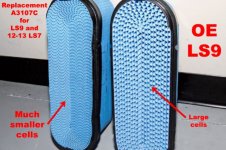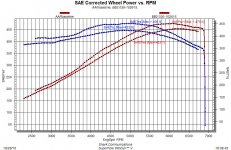My latest adventure with the Blue Bullet II has to do with air filters. Seems mundane, I know, but I have uncovered what could be a:ugh...scandal at ACDelco.
During my last chassis dyno test of my engine with an MSD intake manifold and the OE air filter assembly and an OE air filter, I noted that the power peak moved down 200 rpm. I thought that strange. After some thought and research, I decided a possible reason for the change might be a restrictive air filter, but first...the back story.
Back in 2009, when GM introduced the 638-hp, supercharged, LS9 in the C6 ZR1, it gave that engine a new, less restrictive air filter so support the obvious large increase in airflow from enough to support the LS7's 505-hp to enough to support the LS9's 638-hp.
In 2006, when the LS7 was introduced, it used a new air filter design produced by the Donaldson Company, a filter media Donaldson called "PowerCore". During the LS9 development, GM wanted an air filter of about the same physical size as the LS7 unit to fit in an air filter assembly the size of that used on the LS7. GM went back to Donaldson and it developed a new filter, the same size as the LS7 filter but using a new, less restrictive filter media called "PowerCore G2". The new filters were installed on all LS9s and, up until 2012, were only used on that engine.
For the 2012 model year, in response to more stringent exhaust emissions standards in California, GM put exhaust systems on Corvette with four catylitic converters. While the 4-cat exhaust was not a big deal on the supercharged LS9, on the normally aspirated LS7, it restricted the exhaust enough that the engine's power fell below the 505-hp mark which made the engine famous. During the development of the '12 LS7, GM determined it could reduce intake restriction enough to offset the increase in exhaust restruction such that the power level remained at 505-hp, if it used the LS9 filter made with the Donaldson PowerCore G2 media. As such, all 2012 and 2013, LS7-equipped Z06es and 427 Convertibles used the LS9 air filter.
Fast forward to a year or so ago:
I ordered a new air filter for my 12 Z06 from Amazon.com. When it arrived, I noted the filter media was slightly different but didn't think anything about it at the time.
Then, a month or so ago, I tested the MSD Atomic Air Force intake manifold I installed on the engine and noted that, while peak power and torque improved significantly, that the power peak moved down slightly. I thought that strange and then remembered how the air filter looked different.
I did some research on the Donaldson Company web site and learned that Donaldson has two similar-appearing, but different-performing filter media: "PowerCore" and "PowerCore G2". The web site implied that the PowerCore G2 was capable of higher flow rates but no specific information as to the two media's actual flow rates was given. Imagery on the site indicated that the PowerCore G2 media was the media used in my original LS7 air filter and the older, PowerCore media was used in the replacement, AC Delco A3107C filter I had ordered from Amazon. I contacted Donaldson's Marketing Manger, Rod Radosevich. Initially, Mr. Radosevich suggested I email him some questions. I did so, asking about differences between PowerCore and PowerCore G2. He emailed back saying that Donaldson Company would not answer my questions.
Here is an image showing the difference between the two.

Some more research in the Internet found a statement, the original source unknown, that the PowerCore G2 LS9 and '12/'13 LS7 air filter flowed 850-cfm, a 19% increase in flow over the earlier LS7 filter which was made with PowerCore media.
Then, I took my research in a different direction, trying to better understand AC Delco's current offering for air filters. Turns out that the 2006-2011 Z06 air filter is an A3077C and has always used the PowerCore media. The factory-installed 09-13 LS9/12-13 LS7 filters (GM PN 25940997) used the PowerCore G2 media, however, the AC Delco replacement filters (PN A3107C) I have seen so far, one from Amazon.com and one from Zip Products, both of which were purchased in the last 12 months, use the more-restrictive PowerCore media.
I suspect that ACD confronted with the cost of the PowerCore G2 media decided it was not important to sell the proper filter for LS9s and 12-13 LS7s and ordered it's current stock of LS3, LS7 and LS9 filters from Donaldson to be made with PowerCore rather than PowerCore G2 media.
If that's true, then anyone putting an OE-replacement A3107C filter on an LS9 or LS7 is gong to experience a loss in performance.

ad
So, what am I going to do next?
Well, one thing I want to do is try to find or borrow an NOS LS7 filter made with PowerCore G2 and test it to see if performance improves over my last dyno test. I have found a couple of ZR-1 or late model Z06 owners willing to let me borrow their filters.
More on this story, later, as it develops.:confused




 ad
ad





